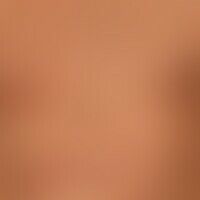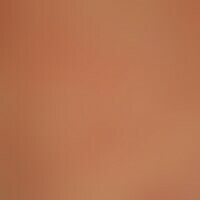Lupus erythematosus acute-cutaneous Images
Go to article Lupus erythematosus acute-cutaneous
lupus erythematosus acute-cutaneous: acute symmetrical skin symptoms after sun exposure, which have persisted for 1 week. pat. was previously free of skin symptoms. clear feeling of tension in the skin. laboratory: ANA+; anti dsDNA antibodies neg.; anti-Ro antibodies positive.

Lupus erythematosus acute-cutaneous: detailed picture

Lupus erythematosus acute-cutaneous: symmetrical red spots, patches and plaques on the face that have been present for several weeks (typical butterfly erythema)

Lupus erythematosus acute-cutaneous: symmetrical red spots, patches and plaques in the face, neck and upper trunk areas that have been present for several weeks.

lupus erythematosus acute-cutaneous: symmetrical red spots, patches and plaques on the face, neck and upper trunk areas, which have been present for several weeks. typical is the perioral recess. note: lip lesion corresponds to a herpes simplex lesion.

Lupus erythematosus acute-cutaneous: symmetric red spots, patches and plaques in the face, neck and upper trunk areas which have been present for several weeks; typical are the perioral and (as shown here) the periorbital recess.

Lupus erythematosus acute-cutaneous: symmetric red spots, patches and plaques on the face, neck and upper trunk, existing for several weeks; lateral image.

lupus erythematosus acute-cutaneous: clinical picture occurred within 14 days, at the time of admission still relapsing-active, with prominent anular patterns. in the current relapse phase fatigue and exhaustion. SPA and CRP significantly increased. ANA 1:160; anti-Ro/SSA antibody positive. DIF: LE - typical.

lupus erythematosus acute-cutaneous: clinical picture known for several years, occurring within 14 days, at the time of admission still with intermittent course. anular pattern. in the current intermittent phase fatigue and exhaustion. ANA 1:160; anti-Ro/SSA antibodies positive. DIF: LE - typical.

lupus erythematosus acute-cutaneous: clinical picture known for several years, occurring within 14 days, at the time of admission still with intermittent course. anular pattern. in the current intermittent phase fatigue and exhaustion. ANA 1:160; anti-Ro/SSA antibodies positive. DIF: LE - typical.

lupus erythematosus acute-cutaneous: large and small succulent plaques, with sharply defined circulatory borders, which occurred within a week in a previously healthy patient. skin detachment with weeping and crust formation in the sternum area. inflammation parameters significantly increased. ANA: 1:320; anti-Ro/SSA and anti-La/SSB antibodies positive.

lupus erythematosus acute-cutaneous: clinical picture known for several years, occurring within 14 days, at the time of admission still with intermittent course. anular pattern. in the current intermittent phase fatigue and exhaustion. ANA 1:160; anti-Ro/SSA antibodies positive. DIF: LE - typical.

lupus erythematosus acute-cutaneous: clinical picture known for several years, occurring within 14 days, at the time of admission still with intermittent progression. anular patterns. circinar desquamation in the area of the plaques. DIF: LE - typical.

Lupus erythematosus acute-cutaneous: a clinical picture known for several years with a variable course of the disease; extensive regression of the acute symptoms under immunosuppressive therapy.

lupus erythematosus acute-cutaneous: clinical picture known for several years, occurring within 14 days, at the time of admission still with intermittent course. anular pattern. in the current intermittent phase fatigue and exhaustion. ANA 1:160; anti-Ro/SSA antibodies positive. DIF: LE - typical.

lupus erythematosus acute-cutaneous: clinical picture known for several years, occurring within 14 days and still with relapsing course at the time of admission. in contrast to the anular pattern on the trunk, irregular, blurred red plaques. in the current relapsing phase fatigue and exhaustion. ANA 1:160; anti-Ro/SSA antibodies positive. DIF: LE - typical.

differential diagnosis "lupus erythematosus acute-cutaneous" : acute erysipelas. acutely appeared, since a few days existing, increasing, flat, sharply defined, pillow-like raised, flaming red and painful swelling of the cheeks. clear impairment of the general condition with fever.